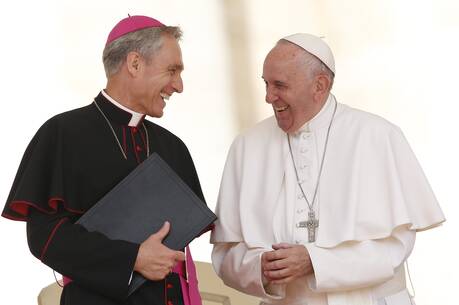“This is a time for the Church to rediscover the meaning of the mission entrusted to her by the Lord on the day of Easter: to be a sign and an instrument of the Father’s mercy”, Pope Francis said in St Peter’s Basilica on April 11, after publishing the Bull of Indiction for the Jubilee of Mercy.
“Jesus is the face of the Father’s mercy” and “It is absolutely essential for the Church and for the credibility of her message that she herself live and testify to mercy. Her language and her gestures must transmit mercy, so as to touch the hearts of all people and inspire them once more to find the road that leads to the Father”, he said in the 15-page Bull of Indiction with which he formally convoked the Jubilee.
“Mercy will always be greater than any sin, and no one can place limits on the love of God who is ever ready to forgive”, he stated in the Bull, the formal document that gives the Pope's rationale for calling the Jubilee, and his vision for it. It also provides the main outline of what will happen in this Holy Year that opens on 8 December 2015 and closes on 20 November 2016.
Following tradition, Francis gave a copy of this bull to the archpriests of the four major Roman basilicas where there will be a Holy Door through which pilgrims will pass. He also handed copies to representatives of the universal Church at a brief ceremony in front of the Holy Door, in the atrium of St Peter’s basilica, attended by cardinals, bishops, clergy and lay people. The brief event also included reading extracts from the Bull.
“This is the time for mercy”, he declared in a homily during sung vespers in the basilica after issuing the Bull. “It is the favorable time to heal wounds, a time not to be weary of meeting all those who are waiting to see and to touch with their hands the signs of the closeness of God, a time to offer everyone the way of forgiveness and reconciliation”, he told thousands of pilgrims in the basilica, and members of the diplomatic corps that were present.
“The Church, in this time of great historical change, is called to offer more evident signs of God’s presence and closeness”, he stated. "This is not the time to be distracted; on the contrary, we need to be vigilant and to reawaken in ourselves the capacity to see what is essential.”
“This is a time for the Church to rediscover the meaning of the mission entrusted to her by the Lord on the day of Easter: to be a sign and an instrument of the Father’s mercy”, he added. It is “a year in which to be touched by the Lord Jesus and to be transformed by his mercy, so that we may become witnesses to mercy”.
As the Bull makes clear, this Jubilee, like all previous ones, will have a Roman dimension, but most of the events and engagement will take place in the local Churches worldwide, and in major shrines in the different countries. It will involve the entire Catholic Church
It the Bull, Pope Francis makes a direct link between the Jubilee of Mercy and the Second Vatican Council (1962-65), and said “the Church feels the need to keep that event alive”. He recalled how the council fathers, inspired by the Holy Spirit, strongly experienced “the need to speak of God to the people of their time in a comprehensible way. The walls which for too long had made the Church a kind of fortress were torn down and the time had come to preach the Gospel in a new way.”
Significantly, he quoted the words of John XXIII to the opening session of that historical event when, indicating the way ahead, he told the council fathers: “Nowadays, the Spouse of Christ prefers to make use of the medicine of mercy rather than that of severity...the Catholic Church, raising the torch of religious truth by means of this ecumenical council, desires to show herself to be the loving mother of all, benign, patient, full of mercy and goodness towards the brethren who are separated from her.”
He also quoted Paul VI’s words at the conclusion of that event in December 1965, when he reminded the council fathers that “the religion of our Council was principally that of charity”; then emphasizing the need for charity and respect for people always, he said “the story of the Good Samaritan was the paradigm of the spirituality of the Council”.
Pope Francis, drawing on the Scriptures, explained that the mercy of God “is not an abstract idea, it is a concrete reality with which He reveals love like that of a father or mother who are moved in the depths of themselves for their own child”. Indeed, he said, “mercy is the key word in the Sacred Scriptures to indicate how God acts towards us”.
“Mercy is the architrave (main beam) that supports the life of the Church” and “her message and witness to the world cannot be without mercy” because “the credibility of the Church passes through the path of loving and compassionate mercy”, he said.
“Perhaps we have long since forgotten how to show and live the way of mercy. The temptation, on the one hand, to focus exclusively on justice made us forget that this is only the first, albeit necessary and indispensable step. But the Church needs to go beyond and strive for a higher and more important goal”, he said.He observed that the idea of pardon has been sidelined too in our culture today but, he said, “Without the witness of pardon life would be unfruitful and sterile”.
He declared that “The time has come to return to the essential, to make our own the weaknesses and difficulties of our brothers and sisters. Pardon is a force that can give rise to new life and infuse courage to look with hope to the future.”
John Paul II saw this clearly too, and wrote an encyclical on mercy, he said. Francis went onto state yet again that “the Church has the mission to announce the mercy of God, the pulsating heart of the Gospel, which through her should reach the mind and heart of every person”. Moreover, the Church has to live and witness to mercy everywhere: in parishes, associations, movements, wherever there are Christians.
The motto of the Holy Year is: “Be merciful like your Father”, Francis stated. This involves “opening our hearts” to those on “the existential peripheries”, to see the wounds of the world and the miseries of our brothers and sisters. He said he wants the Christian people to “reflect on the spiritual and corporal works of mercy” and put them into practice, and suggested how this may be done.
He wants next Lent to be a special time for celebrating and experiencing the mercy of God. He again calls on confessors to be merciful, and understand that “none of us is the Lord of the sacrament; we are faithful servants of the pardon of God”.
Breaking new ground, the Pope said that next Lent he intends to send “missionaries of mercy” into the world, through the local bishops, and give these priest confessors the authority to forgive even those sins that are reserved to the Holy See.
Francis went onto to appeal to those involved in criminal organization and in corruption to take this God-given opportunity to change their lives, and receive God’s mercy.
As expected, he announced that the usual indulgences will be made available to people. He also emphasized the importance of “pilgrimage” during the Jubilee Year.
Though Francis did not make any reference to the synod on the family, which will address the irregular marriage situations of many people, sources say it is no accident that the Jubilee of Mercy will come soon after the conclusion of that synod.
LINK TO FULL ENGLISH TEXT OF THE BULL OF INDICTION OF THE JUBILEE OF MERCY
http://w2.vatican.va/content/francesco/en/apost_letters/documents/papa-francesco_bolla_20150411_misericordiae-vultus.html







